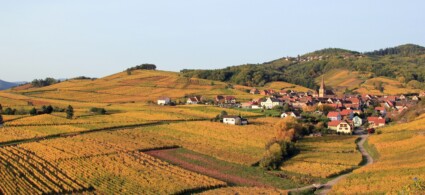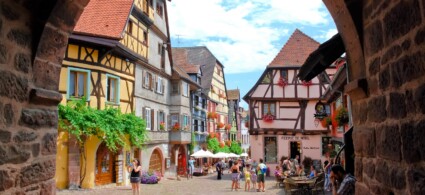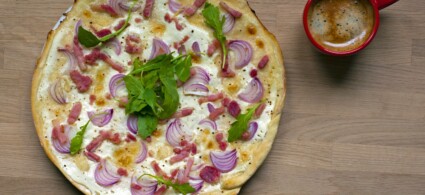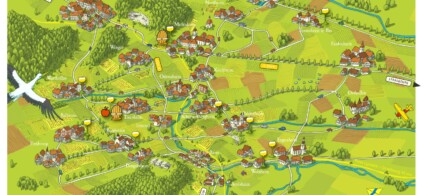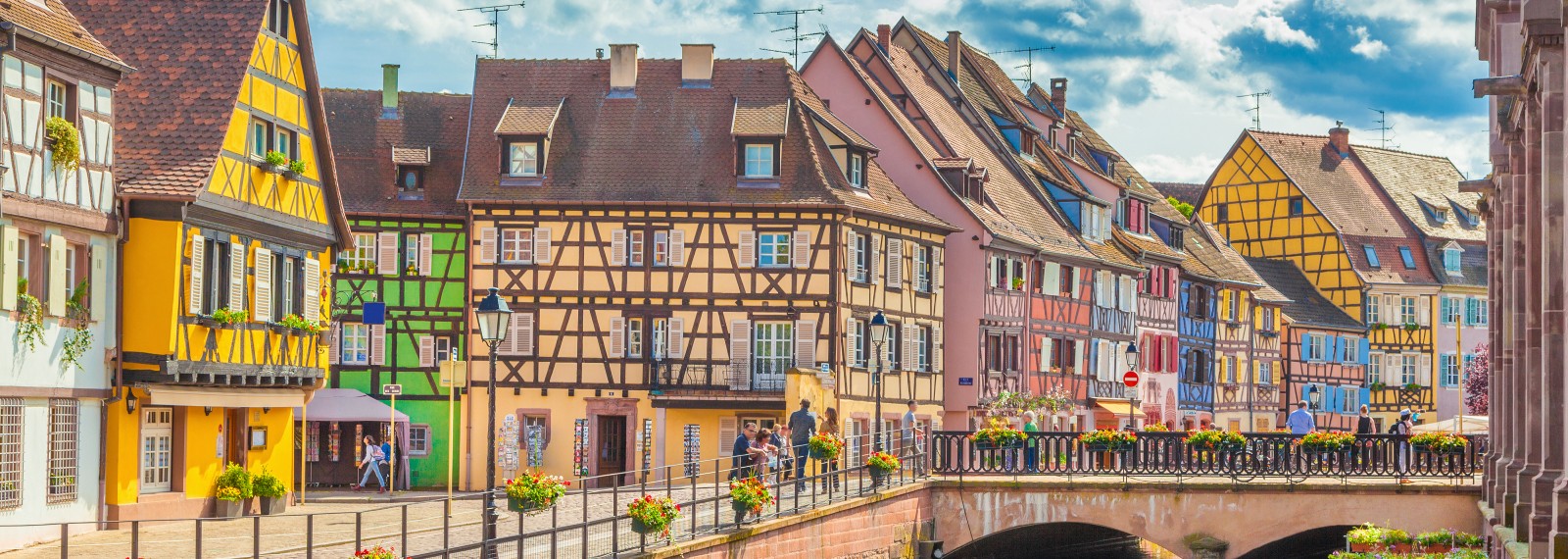

The Alsace-Lorraine region is the easternmost region of France and also marks the natural border between France and Germany. Alsace was disputed for centuries by the two nations and only became French after the First World War, in 1919 with the Treaty of Versailles.
After the administrative reform of 2016, the territories of Alsace-Lorraine and Champagne-Ardenne were united into one new large region, the Grand Est.
Its troubled history, and its proximity to Germany, have shaped its cultural, linguistic and gastronomic identity, giving rise to a unique territory with traditions and cultures that belong to both nations: a region waiting to be discovered that will remain indelibly in your memory.
Alsace enchants visitors with its picturesque villages: the villages with their colourful half-timbered houses seem straight out of a storybook and are surrounded by expanses of vineyards that produce some of the world’s finest wines.
The region is a succession of green valleys, dotted with medieval castles and fortresses perched on mountains. Despite being one of the smallest regions in the country, Alsace offers a picturesque landscape that makes it one of the most beautiful and characteristic regions in France.
Its cities are a harmonious meeting of Latin and Germanic cultures, such as Strasbourg, the cosmopolitan capital, seat of the European Parliament and guardian of a wonderful old historic centre. Its Petite France, the romantic UNESCO heritage district, enchants with its typical half-timbered houses with sloping roofs, reflected in the river channels.
Not to be missed is Colmar, one of Alsace’s most characteristic towns: with its charming half-timbered houses and cobbled medieval streets along the canals of Petite Venice, it will take you back in time.
To immerse yourself in a fairytale atmosphere, you should instead head to Riquewihr, the tiny old village that inspired the Disney cartoonists of Beauty and the Beast.
Eguisheim, on the other hand, is a fabulous medieval village with perfectly preserved double walls: its small but enchanting old town really seems to have come straight out of the pages of a storybook.
But there are many characteristic villages that are worth a visit, such as Ribeauvillé or Kaysersberg; ideally, you should visit them all following the Wine Route itinerary.
Lovers of good wine will not miss the opportunity to visit the Route des Vins, or Wine Route, in Alsace. This is an enchanting route of about 170 km in the middle of the hills, passing through magnificent villages and enchanting vineyards where you can taste the best and most prized wines of Alsace.
Along this bucolic route, you can taste fine Alsatian wines in the area’s many caves, the wine cellars that produce some of Europe’s finest wines such as Riesling, Pinot Blanc, Pinot Gris, Pinot Noir and Gewürztraminer.
The Alsace Wine Route runs from north to south and passes through Ribeauvillé, Riquewihr, Turckheim and Eguisheim to Thann in the Upper Rhine.
If you love the magical atmosphere of Christmas, Alsace is the place for you. Interweaving Alsatian Christmas culture with German tradition, there is no better place in Europe to savour all the fairytale magic of Christmas.
Every town and village is cloaked in charm and transformed into enchanting Christmas villages. In addition to the Strasbourg Christmas Market, the most famous and largest in the region, you can admire countless markets in the most beautiful villages of Alsace.
The most traditional are certainly those of Riquewihr, Ribeauville, Obernai, Mulhouse and Eguisheim, while Colmar’s Christmas market seems to have come straight out of the pages of a Christmas story. The whole town is dressed up and enchants with lights, scents, flavours and decorations on every façade and every window. A daydream for young and old.
The best time to visit Alsace is definitely between May and September: you can enjoy mild temperatures and more daylight hours.
In addition, spring and summer offer a colourful region where the landscapes show all their beauty with green expanses of vineyards and gardens in full bloom. Let’s not forget that during these months, the villages come alive with many events and folk festivals linked to the land and food and wine specialities in which wine, history and popular traditions blend harmoniously.
If, on the other hand, you prefer the autumn months, you will not be disappointed: it is the period of foliage and the expanses of vines light up with wonderful colours. A true spectacle of nature. Here, too, you can enjoy the celebrations and festivities associated with the grape harvest and the new wine.
The winter, which is very cold and often snowy, with decidedly crisp temperatures, is perfect for plunging into the magical atmosphere of Christmas and for taking advantage of the region’s numerous ski facilities.
The fastest way to get to Alsace is certainly by plane. The closest airports are Strasbourg Airport, which only has a few seasonal flights, and Basel-Mulhouse Airport.
Alternatively, you could also consider landing in Germany, at Karlsruhe-Baden Baden Airport, which is only 1 hour from Strasbourg and is served by several low-cost airlines including Ryanair.
To discover this wonderful region, the most commonly chosen places to sleep are Strasbourg and Colmar, the former more ‘European’, the latter much more characteristic but with fewer services and evening activities. In case Strasbourg doesn’t fit into your plans, you should also consider Mulhouse, a small town in the south that enjoys excellent transport links and a strategic location useful for visiting most of the villages, while also winking at neighbouring Switzerland.
Alsace is the easternmost region of France and lies on the border with Germany and Switzerland.


